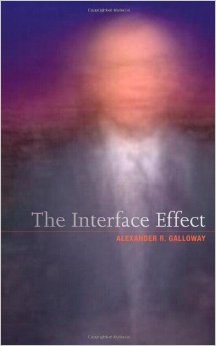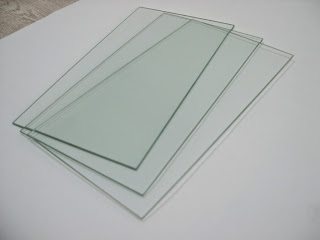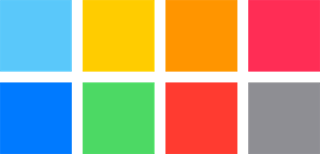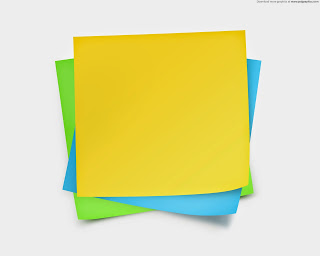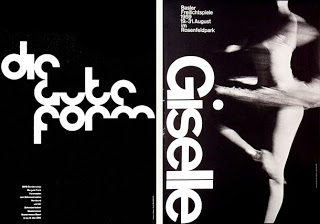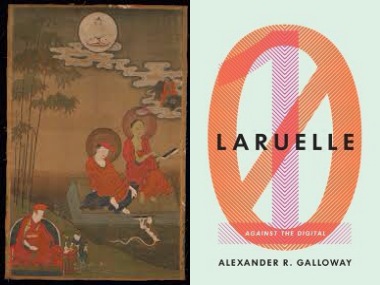a review of Alexander R. Galloway, The Interface Effect (Polity, 2012)
~
This summer marks the twenty-fifth anniversary of the original French publication of Gilles Deleuze’s seminal essay, “Postscript on the Societies of Control” (1990). A strikingly powerful short piece, “Postscript” remains, even at this late date, one of the most poignant, prescient, and concise diagnoses of life in the overdeveloped digital world of the twenty-first century and the “ultrarapid forms of apparently free-floating control that are taking over from the old disciplines.”[1] A stylistic departure from much of Deleuze’s other writing in its clarity and straightforwardness, the essay describes a general transformation from the modes of disciplinary power that Michel Foucault famously analyzed in Discipline and Punish (1975) to “societies of control.” For Deleuze, the late twentieth century is characterized by “a general breakdown of all sites of confinement—prisons, hospitals, factories, schools, the family.”[2] The institutions that were formerly able to strictly organize time and space through perpetual surveillance—thereby, according to Foucault, fabricating the modern individual subject—have become fluid and modular, “continually changing from one moment to the next.”[3] Individuals have become “dividuals,” “dissolv[ed] . . . into distributed networks of information.”[4]
Over the past decade, media theorist Alexander R. Galloway has extensively and rigorously elaborated on Deleuze’s suggestive pronouncements, probably devoting more pages in print to thinking about the “Postscript” than has any other single writer.[5] Galloway’s most important work in this regard is his first book, Protocol: How Control Exists after Decentralization (2004). If the figure for the disciplinary society was Jeremy Bentham’s panopticon, a machine designed to induce a sense of permanent visibility in prisoners (and, by extension, the modern subject), Galloway argues that the distributed network, and particularly the distributed network we call the internet, is an apposite figure for control societies. Rhizomatic and flexible, distributed networks historically emerged as an alternative to hierarchical, rigid, centralized (and decentralized) networks. But far from being chaotic and unorganized, the protocols that organize our digital networks have created “the most highly controlled mass media hitherto known. . . . While control used to be a law of society, now it is more like a law of nature. Because of this, resisting control has become very challenging indeed.”[6] To put it another way: if in 1980 Deleuze and Félix Guattari complained that “we’re tired of trees,” Galloway and philosopher Eugene Thacker suggest that today “we’re tired of rhizomes.”[7]
The imperative to think through the novel challenges presented by control societies and the urgent need to develop new methodologies for engaging the digital realities of the twenty-first century are at the heart of The Interface Effect (2012), the final volume in a trio of works Galloway calls Allegories of Control.[8] Guiding the various inquiries in the book is his provocative claim that “we do not yet have a critical or poetic language in which to represent the control society.”[9] This is because there is an “unrepresentability lurking within information aesthetics” (86). This claim for unrepresentability, that what occurs with digital media is not representation per se, is The Interface Effect’s most significant departure from previous media theory. Rather than rehearse familiar media ecologies, Galloway suggests that “the remediation argument (handed down from McLuhan and his followers including Kittler) is so full of holes that it is probably best to toss it wholesale” (20). The Interface Effect challenges thinking about mimesis that would place computers at the end of a line of increasingly complex modes of representation, a line extending from Plato, through Erich Auerbach, Marshall McLuhan, and Friedrich Kittler, and terminating in Richard Grusin, Jay David Bolter, and many others. Rather than continue to understand digital media in terms of remediation and representation, Galloway emphasizes the processes of computational media, suggesting that the inability to productively represent control societies stems from misunderstandings about how to critically analyze and engage with the basic materiality of computers.
The book begins with an introduction polemically positioning Galloway’s own media theory directly against Lev Manovich’s field-defining book, The Language of New Media (2001). Contra Manovich, Galloway stresses that digital media are not objects but actions. Unlike cinema, which he calls an ontology because it attempts to bring some aspect of the phenomenal world nearer to the viewer—film, echoing Oedipa Maas’s famous phrase, “projects worlds” (11)—computers involve practices and effects (what Galloway calls an “ethic”) because they are “simply on a world . . . subjecting it to various forms of manipulation, preemption, modeling, and synthetic transformation. . . . The matter at hand is not that of coming to know a world, but rather that of how specific, abstract definitions are executed to form a world” (12, 13, 23). Or to take two other examples Galloway uses to positive effect: the difference can be understood as that between language, which describes and represents, encoding a world, versus calculus, which does or simulates doing something to the world; calculus is a “system of reasoning, an executable machine” (22). Though Galloway does more in Gaming: Essays on Algorithmic Culture (2006) to fully develop a way of analyzing computational media that privileges action over representation, The Interface Effect theoretically grounds this important distinction between mimesis and action, description and process.[10] Further, it constitutes a bold methodological step away from some of the dominant ways of thinking about digital media that simultaneously offers its readers new ways to connect media studies more firmly to politics.
Further distinguishing himself from writers like Manovich, Galloway says that there has been a basic misunderstanding regarding media and mediation, and that the two systems are “violently unconnected” (13). Galloway demonstrates, in contrast to such thinkers as Kittler, that there is an old line of thinking about mediation that can be traced very far back and that is not dependent on thinking about media as exclusively tied to nineteenth and twentieth century communications technology:
Doubtless certain Greek philosophers had negative views regarding hypomnesis. Yet Kittler is reckless to suggest that the Greeks had no theory of mediation. The Greeks indubitably had an intimate understanding of the physicality of transmission and message sending (Hermes). They differentiated between mediation as immanence and mediation as expression (Iris versus Hermes). They understood the mediation of poetry via the Muses and their techne. They understood the mediation of bodies through the “middle loving” Aphrodite. They even understood swarming and networked presence (in the incontinent mediating forms of the Eumenides who pursued Orestes in order to “process” him at the procès of Athena). Thus we need only look a little bit further to shed this rather vulgar, consumer-electronics view of media, and instead graduate into the deep history of media as modes of mediation. (15)
Galloway’s point here is that the larger contemporary discussion of mediation that he is pursuing in The Interface Effect should not be restricted to merely the digital artifacts that have occasioned so much recent theoretical activity, and that there is an urgent need for deeper histories of mediation. Though the book appears to be primarily concerned with the twentieth and twenty-first century, this gesture toward the Greeks signals the important work of historicization that often distinguishes much of Galloway’s work. In “Love of the Middle” (2014), for example, which appears in the book Excommunication (2014), co-authored with Thacker and McKenzie Wark, Galloway fully develops a rigorous reading of Greek mediation, suggesting that in the Eumenides, or what the Romans called the Furies, reside a notable historical precursor for understanding the mediation of distributed networks.[11]
In The Interface Effect these larger efforts at historicization allow Galloway to always understand “media as modes of mediation,” and consequently his big theoretical step involves claiming that “an interface is not a thing, an interface is an effect. It is always a process or a translation” (33). There are a variety of positive implications for the study of media understood as modes of mediation, as a study of interface effects. Principal amongst these are the rigorous methodological possibilities Galloway’s focus emphasizes.
In this, methodologically and otherwise, Galloway’s work in The Interface Effect resembles and extends that of his teacher Fredric Jameson, particularly the kind of work found in The Political Unconscious (1981). Following Jameson’s emphasis on the “poetics of social forms,” Galloway’s goal is “not to reenact the interface, much less to ‘define’ it, but to identify the interface itself as historical. . . . This produces . . . a perspective on how cultural production and the socio-historical situation take form as they are interfaced together” (30). The Interface Effect firmly ties the cultural to the social, economic, historical, and political, finding in a variety of locations ways that interfaces function as allegories of control. “The social field itself constitutes a grand interface, an interface between subject and world, between surface and source, and between critique and the objects of criticism. Hence the interface is above all an allegorical device that will help us gain some perspective on culture in the age of information” (54). The power of looking at the interface as an allegorical device, as a “control allegory” (30), is demonstrated throughout the book’s relatively wide-ranging analyses of various interface effects.
Chapter 1, “The Unworkable Interface,” historicizes some twentieth century transformations of the interface, concisely summarizing a history of mediation by moving from Norman Rockwell’s “Triple Self-Portrait” (1960), through Mad Magazine’s satirization of Rockwell, to World of Warcraft (2004-2015). Viewed from the level of the interface, with all of its nondiegetic menus and icons and the ways it erases the line between play and labor, Galloway demonstrates both here and in the last chapter that World of Warcraft is a powerful control allegory: “it is not an avant-garde image, but, nevertheless, it firmly delivers an avant-garde lesson in politics” (44).[12] Further exemplifying the importance of historicizing interfaces, Chapter 2 continues to demonstrate the value of approaching interface effects allegorically. Galloway finds “a formal similarity between the structure of ideology and the structure of software” (55), arguing that software “is an allegorical figure for the way in which . . . political and social realities are ‘resolved’ today: not through oppression or false consciousness . . . but through the ruthless rule of code” (76). Chapter 4 extends such thinking toward a masterful reading of the various mediations at play in a show such as 24 (2001-2010, 2014), arguing that 24 is political not because of its content but “because the show embodies in its formal technique the essential grammar of the control society, dominated as it is by specific network and informatic logics” (119). In short, The Interface Effect continually demonstrates the potent critical tools approaching mediation as allegory can provide, reaffirming the importance of a Jamesonian approach to cultural production in the digital age.
Whether or not readers are convinced, however, by Galloway’s larger reworking of the field of digital media studies, his emphasis on attending to contemporary cultural artifacts as allegories of control, or his call in the book’s conclusion for a politics of “whatever being” probably depends upon their thoughts about the unrepresentability of today’s global networks in Chapter 3, “Are Some Things Unrepresentable?” His answer to the chapter’s question is, quite simply, “Yes.” Attempts to visualize the World Wide Web only result in incoherent repetition: “every map of the internet looks the same,” and as a result “no poetics is possible in this uniform aesthetic space” (85). He argues that, in the face of such an aesthetic regime, what Jacques Rancière calls a “distribution of the sensible”[13]:
The point is not so much to call for a return to cognitive mapping, which of course is of the highest importance, but to call for a poetics as such for this mysterious new machinic space. . . . Today’s systemics have no contrary. Algorithms and other logical structures are uniquely, and perhaps not surprisingly, monolithic in their historical development. There is one game in town: a positivistic dominant of reductive, systemic efficiency and expediency. Offering a counter-aesthetic in the face of such systematicity is the first step toward building a poetics for it, a language of representability adequate to it. (99)
There are, to my mind, two ways of responding to Galloway’s call for a poetics as such in the face of the digital realities of contemporaneity.
On the one hand, I am tempted to agree with him. Galloway is clearly signaling his debt to some of Jameson’s more important large claims and is reviving the need “to think the impossible totality of the contemporary world system,” what Jameson once called the “technological” or “postmodern sublime.”[14] But Galloway is also signaling the importance of poesis for this activity. Not only is Jamesonian “cognitive mapping” necessary, but the totality of twenty-first century digital networks requires new imaginative activity, a counter-aesthetics commensurate with informatics. This is an immensely attractive position, at least to me, as it preserves a space for poetic, avant-garde activity, and indeed, demands that, all evidence to the contrary, the imagination still has an important role to play in the face of societies of control. (In other words, there may be some “humanities” left in the “digital humanities.”[15]) Rather than suggesting that the imagination has been utterly foreclosed by the cultural logic of late capitalism—that we can no longer imagine any other world, that it is easier to imagine the end of the world than a better one—Galloway says that there must be a reinvestment in the imagination, in poetics as such, that will allow us to better represent, understand, and intervene in societies of control (though not necessarily to imagine a better world; more on this below). Given the present landscape, how could one not be attracted to such a position?
On the other hand, Galloway’s argument hinges on his claim that such a poetics has not emerged and, as Patrick Jagoda and others have suggested, one might merely point out that such a claim is demonstrably false.[16] Though I hope I hardly need to list some of the significant cultural products across a range of media that have appeared over the last fifteen years that critically and complexly engage with the realities of control (e.g., The Wire [2002-08]), it is not radical to suggest that art engaged with pressing contemporary concerns has appeared and will continue to appear, that there are a variety of significant artists who are attempting to understand, represent, and cope with the distributed networks of contemporaneity. One could obviously suggest Galloway’s argument is largely rhetorical, a device to get his readers to think about the different kinds of poesis control societies, distributed networks, and interfaces call for, but this blanket statement threatens to shut down some of the vibrant activity that is going on all over the world commenting upon the contemporary situation. In other words, yes we need a poetics of control, but why must the need for such a poetics hinge on the claim that there has not yet emerged “a critical or poetic language in which to represent the control society”? Is not Galloway’s own substantial, impressive, and important decade-long intellectual project proof that people have developed a critical language that is capable of representing the control society? I would certainly answer in the affirmative.
There are some other rhetorical choices in the conclusion of The Interface Effect that, though compelling, deserve to be questioned, or at least highlighted. I am referring to Galloway’s penchant—following another one of his teachers at Duke, Michael Hardt—for invoking a Bartlebian politics, what Galloway calls “whatever being,” as an appropriate response to present problems.[17] In Hardt and Antonio Negri’s Empire (2000), in the face of the new realities of late capitalism—the multitude, the management of hybridities, the non-place of Empire, etc.—they propose that Herman Melville’s “Bartleby in his pure passivity and his refusal of any particulars presents us with a figure of generic being, being as such, being and nothing more. . . . This refusal certainly is the beginning of a liberatory politics, but it is only a beginning.”[18] Bartleby, with his famous response of “‘I would prefer not to,’”[19] has been frequently invoked by such substantial figures as Giorgio Agamben in the 1990s and Slavoj Žižek in the 2000s (following Hardt and Negri). Such thinkers have frequently theorized Bartleby’s passive negativity as a potentially radical political position, and perhaps the only one possible in the face of global economic realities.[20] (And indeed, it is easy enough to read, say, Occupy Wall Street as a Bartlebian political gesture.) Galloway’s response to the affective postfordist labor of digital networks, that “each and every day, anyone plugged into a network is performing hour after hour of unpaid micro labor” (136), is similarly to withdraw, to “demilitarize being. Stand down. Cease participating” (143).
Like Hardt and Negri and so many others, Galloway’s “whatever being” is a response to the failures of twentieth century emancipatory politics. He writes:
We must stress that it is not the job of politics to invent a new world. On the contrary it is the job of politics to make all these new worlds irrelevant. . . . It is time now to subtract from this world, not add to it. The challenge today is not one of political or moral imagination, for this problem was solved ages ago—kill the despots, surpass capitalism, inclusion of the excluded, equality for all of humanity, end exploitation. The world does not need new ideas. The challenge is simply to realize what we already know to be true. (138-39)
And thus the tension of The Interface Effect is between this call for withdrawal, to work with what there is, to exploit protocological possibility, etc., and the call for a poetics of control, a poesis capable of representing control societies, which to my mind implies imagination (and thus, inevitably, something different, if not new). If there is anything wanting about the book it is its lack of clarity about how these two critical projects are connected (or indeed, if they are perhaps the same thing!). Further, it is not always clear what exactly Galloway means by “poetics” nor how a need for a poetics corresponds to the book’s emphasis on understanding mediation as process over representation, action over objects. This lack of clarity may be due in part to the fact that, as Galloway indicates in his most recent work, Laruelle: Against the Digital (2014), there is some necessary theorization that he needs to do before he can adequately address the digital head-on. As he writes in the conclusion to that book: “The goal here has not been to elucidate, promote, or disparage contemporary digital technologies, but rather to draft a simple prolegomenon for future writing on digitality and philosophy.”[21] In other words, it seems like Allegories of Control, The Exploit: A Theory of Networks (2007), and Laruelle may constitute the groundwork for an even more ambitious confrontation with the digital, one where the kinds of tensions just noted might dissolve. As such, perhaps the reinvocation of a Bartlebian politics of withdrawal at the end of The Interface Effect is merely a kind of stop-gap, a place-holder before a more coherent poetics of control can emerge (as seems to be the case for the Hardt and Negri of Empire). Although contemporary theorists frequently invoke Bartleby, he remains a rather uninspiring figure.
These criticisms aside, however, Galloway’s conclusion of the larger project that is Allegories of Control reveals him to be a consistently accessible and powerful guide to the control society and the digital networks of the twenty-first century. If the new directions in his recent work are any indication, and Laruelle is merely a prolegomenon to future projects, then we should perhaps not despair at all about the present lack of a critical language for representing control societies.
_____
Bradley J. Fest teaches literature at the University of Pittsburgh. At present he is working on The Nuclear Archive: American Literature Before and After the Bomb, a book investigating the relationship between nuclear and information technology in twentieth and twenty-first century American literature. He has published articles in boundary 2, Critical Quarterly, and Studies in the Novel; and his essays have appeared in David Foster Wallace and “The Long Thing” (2014) and The Silence of Fallout (2013). The Rocking Chair, his first collection of poems, is forthcoming from Blue Sketch Press. He blogs at The Hyperarchival Parallax.
Back to the essay
_____
[1] Though best-known in the Anglophone world via the translation that appeared in 1992 in October as “Postscript on the Societies of Control,” the piece appears as “Postscript on Control Societies,” in Gilles Deleuze, Negotiations: 1972-1990, trans. Martin Joughin (New York: Columbia University Press, 1995), 178. For the original French see Gilles Deleuze, “Post-scriptum sur des sociétés de contrôle,” in Pourparlers, 1972-1990 (Paris: Les Éditions de Minuit, 1990), 240-47. The essay originally appeared as “Les sociétés de contrôle,” L’Autre Journal, no. 1 (May 1990). Further references are to the Negotiations version.
[2] Ibid.
[3] Ibid., 179.
[4] Alexander R. Galloway, Protocol: How Control Exists after Decentralization (Cambridge, MA: MIT Press, 2004), 12n18.
[5] In his most recent book, Galloway even goes so far as to ask about the “Postscript”: “Could it be that Deleuze’s most lasting legacy will consist of 2,300 words from 1990?” (Alexander R. Galloway, Laruelle: Against the Digital [Minneapolis: University of Minnesota Press, 2014], 96, emphases in original). For Andrew Culp’s review of Laruelle for The b2 Review, see “From the Decision to the Digital.”
[6] Galloway, Protocol, 147.
[7] Gilles Deleuze and Félix Guattari, A Thousand Plateaus: Capitalism and Schizophrenia, trans. Brian Massumi (Minneapolis: University of Minnesota Press, 1987), 15; and Alexander R. Galloway and Eugene Thacker, The Exploit: A Theory of Networks (Minneapolis: University of Minnesota Press, 2007), 153. For further discussions of networks see Alexander R. Galloway, “Networks,” in Critical Terms for Media Studies, ed. W. J. T. Mitchell and Mark B. N. Hansen (Chicago: University of Chicago Press), 280-96.
[8] The other books in the trilogy include Protocol and Alexander R. Galloway, Gaming: Essays on Algorithmic Culture (Minneapolis: University of Minnesota Press, 2006).
[9] Alexander R. Galloway, The Interface Effect (Malden, MA: Polity, 2012), 98. Hereafter, this work is cited parenthetically.
[10] See especially Galloway’s masterful first chapter of Gaming, “Gamic Action, Four Moments,” 1-38. To my mind, this is one of the best primers for critically thinking about videogames, and it does much to fundamentally ground the study of videogames in action (rather than, as had previously been the case, in either ludology or narratology).
[11] See Alexander R. Galloway, “Love of the Middle,” in Excommunication: Three Inquiries in Media and Mediation, by Alexander R. Galloway, Eugene Thacker, and McKenzie Wark (Chicago: University of Chicago Press, 2014), 25-76.
[12] This is also something he touched on in his remarkable reading of Donald Rumsfeld’s famous “unknown unknowns.” See Alexander R. Galloway, “Warcraft and Utopia,” Ctheory.net (16 February 2006). For a discussion of labor in World of Warcraft, see David Golumbia, “Games Without Play,” in “Play,” special issue, New Literary History 40, no. 1 (Winter 2009): 179-204.
[13] See the following by Jacques Rancière: The Politics of Aesthetics: The Distribution of the Sensible, trans. Gabriel Rockhill (New York: Continuum, 2004), and “Are Some Things Unrepresentable?” in The Future of the Image, trans. Gregory Elliott (New York: Verso, 2007), 109-38.
[14] Fredric Jameson, Postmodernism; or, the Cultural Logic of Late Capitalism (Durham, NC: Duke University Press, 1991), 38.
[15] For Galloway’s take on the digital humanities more generally, see his “Everything Is Computational,” Los Angeles Review of Books (27 June 2013), and “The Cybernetic Hypothesis,” differences 25, no. 1 (Spring 2014): 107-31.
[16] See Patrick Jagoda, introduction to Network Aesthetics (Chicago: University of Chicago Press, forthcoming 2015).
[17] Galloway’s “whatever being” is derived from Giorgio Agamben, The Coming Community, trans. Michael Hardt (Minneapolis: University of Minnesota Press, 1993).
[18] Michael Hardt and Antonio Negri, Empire (Cambridge, MA: Harvard University Press, 2000), 203, 204.
[19] Herman Melville, “Bartleby, The Scrivener: A Story of Wall-street,” in Melville’s Short Novels, critical ed., ed. Dan McCall (New York: W. W. Norton, 2002), 10.
[20] See Giorgio Agamben, “Bartleby, or On Contingency,” in Potentialities: Collected Essays in Philosophy, trans. and ed. Daniel Heller-Roazen (Stanford: Stanford University Press, 1999), 243-71; and see the following by Slavoj Žižek: Iraq: The Borrowed Kettle (New York: Verso, 2004), esp. 71-73, and The Parallax View (New York: Verso, 2006), esp. 381-85.
[21] Galloway, Laruelle, 220.
